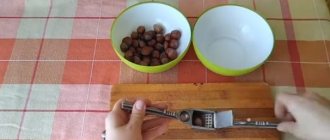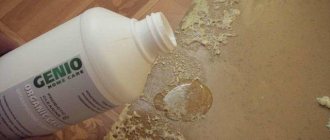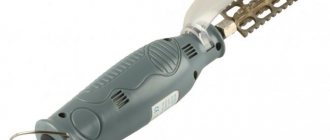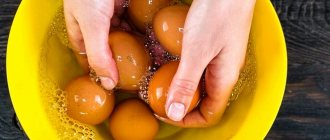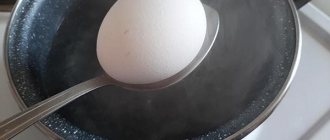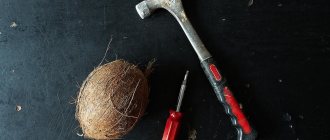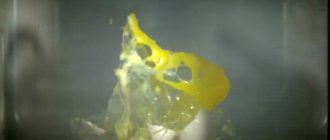Sometimes the simple procedure of freeing eggs from their shells becomes a real culinary test, annoying even experienced housewives: either almost all the whites are removed along with the shells, or the film clings to the fingers, or the shell cracks unevenly, making it possible to peel the egg only in small areas. All this is long and tedious. All this can be used when you have a lot of time to spare.
What if guests are on the doorstep and have ordered your signature dish: meatloaf with eggs or salad, the main ingredient of which is a boiled egg? Or rather, a lot of eggs...
How to quickly peel eggs so that they look neat, take little time, and don’t ruin your nerves? There are ways!
How to hard boil eggs so that they peel well after boiling
Many housewives neglect such a simple action as washing eggs. But, knowing the process of the birth of an egg, it is not difficult to guess that on the surface of the eggshell there may be various microbes, one of which is salmonella - the main culprit of the disease salmonellosis. Therefore, eggs must be washed in warm water and soap before use.
During cooking, eggshells sometimes crack. This occurs due to the sharp temperature difference when an egg from the refrigerator immediately falls into boiling water. Therefore, eggs intended for boiling must be removed from the refrigerator in advance and left on the table so that they warm up to room temperature.
Age and cooling
Surely, housewives with experience know that it is much easier to peel old eggs. If you know in advance that you need to cook hard-boiled eggs, for example, for a birthday or some other holiday, it is better to use eggs that have been in the refrigerator for at least a week.
To clean, take eggs that have already cooled after boiling. This will make it much easier to cope with this task.
Just a glass
If your lungs are not particularly powerful, and rolling an egg on a surface is boring, use the most popular method in recent years. A YouTube video demonstrating the cleaning is wildly popular. You need to place the egg to be peeled in a thick-walled glass, fill it with cold water, cover it tightly with your palm and shake vigorously. A few seconds - and the shell cracks so much that it can be removed with a slight movement of the hand. And often it is removed on its own thanks to water penetrating into the cracks. So there is a great chance of getting an almost clean egg out of the glass.
Our housewives have improved the technique. Really, why the extra effort of pressing? And water can splash out if your palm slips. So we take any fairly wide jar with a screw-on lid and carry out the above-described manipulations, but in more comfortable conditions.
By the way, this is a great option for how to quickly peel eggs if there are a lot of them. Just instead of a jar, we take a plastic container of sufficient size and with a tight-fitting lid.
What is good about this technique is that it removes shell crumbs from the egg. There is no need to inspect the ingredient for foreign inclusions in the future salad.
Option 5: for peeling multiple eggs
https://youtube.com/watch?v=sCNV83HQz-4
What if you need to peel several eggs? Do you really have to use a method every time? It’s not at all necessary, because in fact it’s much easier to peel several eggs at once than one at a time.
You just need to place 5-6 pieces in a fairly capacious plastic container, pour in a little cold water, and close the lid tightly. After this, pick it up and shake vigorously for 2–4 seconds.
During shaking, the eggs will hit the walls and each other, which will invariably lead to damage and even partial removal of the shell. All that remains is to open the container and take out almost completely peeled eggs.
If you don't have a container on hand, you can use a small saucepan or any other container that can be covered with a lid. The result will be just as pleasant and fast.
Methods for storing chicken eggs
There are usually no difficulties with storing chicken products. You can store it both in the refrigerator and at room temperature, making some manipulations.
Cold storage
If you store the product in the refrigerator door, then this is wrong. The air temperature on the side shelves is 4-5 degrees higher than in the entire refrigerator. And constantly closing and opening the door does not have the best effect on the eggs. Therefore, it is best to store eggs on the lower shelves closer to the back wall. This place is considered the coolest.
It's better if you place them pointy end down inside the tray. This is necessary for longer freshness of the product, since at the blunt end there is a small accumulation of air between the shell and the protein. The second reason is the possibility of accumulation of pathogenic bacteria inside the airspace. While at the bottom, they will gradually rise to the top, thereby hitting the squirrels.
Important!
The optimal storage temperature is 4 degrees above zero. This way the product will stay fresh for up to 5 weeks.
If you are interested in how long boiled eggs can be stored, then their maximum period is up to a week. Provided that the shell is intact. In purified form – no more than 2 days. The location in the refrigerator does not matter.
How to choose condensed
milk Condensed milk is a viscous, sweet, aromatic pleasure that comes from childhood. After all, cakes and pastries were made from it...
Storing eggs at room temperature
There are 2 more common methods:
- The product is wrapped in a paper napkin, 1 piece at a time. In this case, the shell will not absorb excess moisture and unpleasant odors. The napkin can be replaced with baking paper or newspaper. The shelf life will be up to 7-10 days. Provided the room is cool. Therefore, this method is not suitable during the hot season.
- Prepare a solution from 1 liter of water and 25 g of salt. Dip the eggs into it and put it in a dark place. In this way, you can preserve the egg for up to 26-28 days.
From all of the above, we can conclude that the best place to store eggs is the refrigerator.
Determining product freshness
On store-bought eggs, you can look at the production date and determine the approximate shelf life. But sometimes stale eggs are sold at the market, so if you still like homemade eggs, take them from a trusted person.
How to quickly determine the degree of freshness of a product? Simply dip the egg in a container of salted water:
- fresh - it will lie on the bottom sideways;
- 7-day – located at an angle of 45 degrees;
- 2-3 weeks - will stand upright, end down.
Important!
If it surfaces, then under no circumstances eat such an egg. Discard it carefully without breaking it.
You can check freshness by shaking. If the egg is of high quality, there will be no sounds. If there is squelching, the product is spoiled. Do not eat specimens with cloudy protein.
Criterias of choice
If the product is purchased from private sellers at the bazaar, then the quality is high, the baked goods will be fluffy and aromatic, and the dishes will have a rich taste. This purchase is considered successful under one condition: when the sellers have a quality laboratory report in their hands.
In the store you need to pay attention to the labeling. The letter D indicates that the product is no more than 7 days old; it becomes table-ready a week after it arrives from the poultry farm.
If storage conditions are met, they can remain on the shelf for up to 3 months.
It is better to focus on information about the sorting date. It will more accurately indicate the delivery time of the product to the store. Another sign of inclusion in a certain category is mass. The smallest ones belong to category 3. By the way, size has absolutely no effect on the taste and speed of removing the shell from the cooked product. The most important indicator of freshness is its dense structure. This egg fits pleasantly in the palm of your hand and does not make any extraneous sounds when shaken.
Taking into account the options for choosing wisely and methods for quickly peeling eggs, the holiday dish will be prepared on time with minimal effort.
how to properly store eggs
Why boiled eggs can be difficult to peel
Each egg behaves differently when boiled, but there are general patterns. Knowledge of the physiology of this living product allows you to organize the process of preparing it correctly, and then clean it without hassle.
Table No. 1. How to boil eggs so that they peel well: success factors.
What to pay attention to How to put it into practice Age of the product Fresh germs only from chicken are the worst to clean, it is better to let them sit in the refrigerator for at least 3-5 days. Their age must be taken into account if we are talking about a homemade product from your own backyard or one that is purchased directly from a farmer or owner of a personal subsidiary plot
Products from the supermarket do not need additional aging: while they are packaged and taken to the store, enough time passes for them to “age.” Immersion water temperature To achieve the desired result, it is better to first leave the product removed from the refrigerator shelves at room temperature, while heating the water in the pan. This approach will prevent the embryo from bursting in boiling water, and the “hot start” will eliminate the possibility of the slowly coagulating protein sticking to the shell. Cooking time Whites set in the first minutes of heat treatment, yolks require more time. To obtain a well-cooked product, it is worth extending the cooking period from the usual 8-10 minutes to 15. Water temperature for cooking The higher the temperature, the stronger the amino acid bonds in proteins become, therefore, in order not to end up with “rubber” eggs that squeak on your teeth as a result of cooking , the heating power is reduced half a minute after lowering the product into boiling water, leaving the fire at medium level.
Blow into the egg
This method is suitable for people with great lung strength. To do this, you need to make holes at both ends of the egg. About the size of a coin. After this, you need to lean your mouth against one of the holes, pressing your lips tightly to the product. After that, you need to blow hard. If successful, the egg will simply fall out the other end. This method will also work if the egg was of good quality, fresh and without damage to the integrity of the shell. You also need to understand that it is also important to cook the product correctly.
The most spectacular and funniest option is what my grandfather showed me in the first place.
- The boiled egg should be cooled slightly, tapped on different sides and rolled on the table - it should be covered with a network of cracks.
- We pick out the shell on the “nose” so that we get a “bald spot” about a centimeter in diameter.
- On the “butt” we pick out the shell a little larger – 2–2.5 cm in diameter.
- We lightly hold the egg in our fist and blow into it with all our strength from the side of the nose, pressing our lips to the shell. Voila - the boiled egg pops out of its “shirt”.
Of course, this method is suitable for entertaining children, but few people want to use it as an everyday thing. Therefore, for your attention - Method 1.5: just tap and roll the egg to make it easier to peel.
How to quickly peel boiled eggs: 5 easiest ways
Boiled eggs, which are fairly easy to peel, are preferably steamed or in a slow cooker. This helps to avoid the troubles that arise when immersing embryos in boiling water, and also significantly speeds up the process.
Expert opinion
Ekaterina Korneva, expert in the field of care, cleanliness and beauty
I will help you understand all the intricacies.
The multicooker, in addition to a stable temperature, also creates a certain pressure, which gives significance to every new second of the process. Scrupulous even in small things, punctual to the second when you need to sit down for breakfast on time, they know perfectly well how to quickly peel eggs: you need to lightly press the shell from all sides so that it cracks, then insert a teaspoon under it, and with its help quickly peel the egg . How to peel a hard-boiled egg in 3 seconds If you have any questions, please contact me, I will be happy to answer!
How to boil an egg so that it is easy to peel
Before you clean the cooked product, you need to cook it properly. Only then will all methods begin to work correctly. So, to properly boil an egg you need:
Buy a good quality product
It doesn’t matter what color the eggs are, as long as they are fresh. You also need to check the shell for integrity
How can you check if the eggs have gone bad? To do this, you need to put them in water and see what happens. A product with a good shelf life will immediately sink to the bottom and take a horizontal position. If it has a smell, it will float up with the blunt end up. If it stays in the middle, then most likely the shelf life of such an egg is coming to an end. For the same purposes, you can shake the egg in your hand: a fresh one will not flop around, and vice versa. Properly preparing the egg before boiling is also important. To do this, you must first rinse the product under water. Let warm slightly at room temperature. When cooking, it is not advisable to put the product in cold water and wait for it to boil. It is better to wait for the right water temperature and start cooking. It is important to observe the cooking time. Depending on what result you want, it will be different. So, if you need to hard boil an egg, it will take only 9 minutes. It will be completely hardened but soft in texture. In order to get a slightly softened yolk, you need to boil the egg for 8 minutes. To achieve a completely liquid yolk, you need to wait 6 minutes. 5 minutes. Enough to get the egg into the bag. To soft-boil the product, you need to wait only 3 minutes. Proper cooling. After the required time has passed, you need to remove the container where the eggs were boiled from the heat. Drain the hot water and place them under a stream of cold water. You should not keep them there until they cool completely. A couple of minutes will be enough.
Simple ways to break an egg without damaging the yolk
A common mistake made by home cooks is cracking the shell on the edge of the dish where they are kneading dough, whipping an omelet, or preparing something else. The result in this case is the appearance of small particles of the hard shell in the finished dish or the spreading of the yolk, whereas in a number of recipes it is required to keep it whole.
To prevent this, you should not break the shell on the edge of the dish or open them with a knife - even the sharpest one, since the correct angle of impact is difficult to calculate. With this method, even experienced cooks can get shells into the dish and often damage the yolk. There are other, already proven and proven techniques that help you quickly and easily cope with the task.
Before breaking an egg, you need to thoroughly clean it. There are many harmful microorganisms on the surface. But, you should wash the shell only before using the product, since it cannot be stored for a long time after cleaning - the shelf life is reduced to 4 days.
How to Boil Eggs So They're Easy to Peel
Kenji Lopez-Alt is a famous American chef and author of books on culinary topics. He explained how to boil eggs to achieve easy peeling.
It is believed that cooled boiled eggs are easier to peel - but this is not true. In fact, the secret to easily peeling eggs is their temperature before they are placed in the water.
Ideally, the cook should take the eggs out of the refrigerator at least 15-30 minutes before cooking so that they have time to warm to room temperature. But we understand that this is not always possible. Therefore, here is a trick for you - put cold eggs in already boiling water. What is the point of this trick?
If we put an egg in cold water and then bring it to a boil, the white will stick tightly to the shell. This makes cleaning difficult, and an egg without a shell usually doesn't look very nice. And it’s kind of a pity to throw away half the protein with the shell.
On the left you can see peeled eggs that were placed immediately in cold water, and on the right you can see those that were left to cook after boiling.
This approach also has a disadvantage - displacement of the yolk. An egg in boiling water immediately begins to flop, and because of this, the yolk changes its position. If this moment is critical for you, then your choice is steaming. Buy a special pan rack and place it on the bottom. Pour about 2-4 cm of water into the pan and bring to a boil. Place the eggs on the rack and cook for 11 minutes.
Steamed eggs taste no different from regular boiled eggs.
What affects ease of cleaning?
The main factors for easy shelling of eggs are the freshness of the product and the temperature of the water in which the egg is immersed before cooking.
Very fresh eggs are difficult to peel. Therefore, if you take the product directly from the chicken, you need to wait 1-2 weeks for it to mature. Then you can get the perfect egg shape for stuffing or coloring for Easter.
Another important point: what kind of water to put the eggs in for boiling - cold or hot. To make the shell come off easier, the liquid must be brought to high temperatures. When using cold water, the egg white will heat up along with the liquid and stick tightly to the shell.
How to quickly peel quail eggs
They are healthy, have a pleasant taste, different from their chicken “brothers”, and are an essential ingredient in many delicious dishes. And at the same time they have a significant drawback: small sizes. Peeling quail eggs is a real pain. Most often, cooks carry out these manipulations under running water, since otherwise there is no way to remove tiny shell fragments. And at the same time he curses his culinary fantasies, which led to such a tedious task. But the described know-how is unsuitable for quail eggs: the end result is an unappetizing mixture of shell and its contents.
However, the problem can be overcome. To get rid of cleaning difficulties, boiled quail eggs need to be placed in an enamel deep bowl and filled with a vinegar solution. And strong: for one serving of water, take two parts of table vinegar. The eggs will have to sit in the mixture for at least two hours. Maybe longer. But then only a thin film will remain of the shell, which can be easily washed off under the tap.
So peeling eggs is not at all as boring as it seems at first glance. Everything can be done quickly and cleanly, which will speed up the time for the more interesting stages of cooking.
Cleaning Rules
Creating a temperature difference between the internal and external environments will help to clean the shell quickly and well - place a hot egg in cold water for a quarter of an hour (or half an hour). A puncture made from the blunt side will make the procedure easier - a little water will get inside and the shell will easily separate from the shell.
Simple methods will help you quickly remove the shell from one or more eggs:
- if there is only one egg, then pour a little water into a glass and, covering the top, shake vigorously; if there are more, then pour water, for example, into a saucepan, and shake the same way - the shell will crack and come off easily;
- remove just a little shell from the narrow edge, a little more from the blunt edge and blow out the contents, directing a stream of air into the narrow hole;
- roll the egg so that the shell breaks, or break the integrity by hitting another object, but in both cases it is better to clean it in water or under running water.
On a note!
The white and yolk, plastic in their structure, quickly occupy the entire volume in very cold water, and the surface of the egg becomes smooth.
Washing eggs before storage
What are the reasons that most people choose to wash eggs before storing? Some people, out of habit, wash all food before putting it in the refrigerator. But the most important reason is the fear of contracting salmonellosis. In this case, you need to understand that the infection comes from the chickens themselves, and not from the laid eggs. If birds are not kept properly, salmonellosis can spread extremely quickly. As for the egg, bacteria are found only on the shell. It is especially dangerous when there are remains of droppings on it.
Important!
Chicken eggs cannot be washed. Otherwise, the protective film covering the shell is removed. This causes the product to deteriorate faster. Therefore, store washed specimens for no more than 5 days, and store untreated ones for 30 days. The difference is quite noticeable.
Do I need to wash store-bought eggs? If there are any remaining droppings on them, carefully wipe them off with a dry cloth. And just before use, wash in hot water and soap.
To protect yourself from pathogenic bacteria, adhere to the following rules:
- Buy whole eggs without damage to the shell. Even if a small crack is visible on the product, infection can penetrate through it. Then the risk of contracting salmonellosis increases.
- After cooking, immediately throw away the shells, and wash all used items in hot soapy water, rinse and wipe with vinegar.
- Store eggs in a separate container with a lid, away from contact with other products.
- Prefer products from small poultry farms. Chicken care from such producers is much better than from large enterprises.
Preventive measures
If you are interested in how to quickly peel boiled eggs, but you don’t want to master any techniques, even simple ones, you can make it easier for yourself using the traditional method. Before immersing the product in water, you just need to dissolve a spoonful of baking soda in it. It raises the pH value of the protein, and the film between it and the shell loses its stickiness. It will be much easier to separate.
Another secret is boiling the eggs under the lid. There is no technical explanation for the phenomenon; physicists have probably never been interested in this issue. But experienced chefs assure that the trick works. And if you know about it, you will never again wonder how to quickly peel eggs. And this will make your culinary life much easier.
What to do to make eggs easy to peel
When the eggs are boiled, there is no point in discussing whether the conditions for their preparation were good or bad: now they should be peeled quickly and without loss. At this stage, the determining factors for success are temperature and cooling rate.
The shell comes off more easily from completely cooled germs, even if their freshness was at their highest at the time of preparation. To ensure that the product cools as quickly as possible, it is permissible to use the refrigerator or freezer by placing it on the appropriate shelf, tightly closed in an airtight container.
Does cold water help cleaning?
Immersing the product in cold, or preferably ice, water is the easiest way to prepare for cleaning. As it warms up, it must be drained, filling the bowl with new liquid at the desired temperature until the whites and yolks have cooled completely. The procedure usually takes about 15 minutes.
After cooking and complete cooling, the shells are quickly cleaned under running cool tap water. Before the procedure, it is advisable to crush it by crushing the egg in your hands between your fingers.
Should you roll eggs on the countertop?
It is possible to crush the shell faster by rolling the product on the table like dough. The cracked shell remains on the film lining it from the inside, and will be removed along with it when the time comes to completely peel the boiled egg.
Shaking
If you need to quickly get a significant amount of peeled boiled eggs, it is better to use the shaking method. The finished products are placed tightly in a pan under a lid, and then vigorously shaken. At the same time, the shell cracks, separating from the protein, and the spaces between them are filled with air.
Will the egg fly out under the air flow?
Another interesting way to peel hard-boiled eggs requires some skill. To implement it, holes of sufficient size are made at the blunt and sharp end of the product, and then the contents are blown out, catching it at the exit.
Should you use baking soda?
Adding salt and baking soda to boil the eggs makes them easier to clean later by preventing them from cracking too much. The reason for this is a change in the density of the medium, but this method cannot be considered a panacea.
I boil eggs so that the shell easily separates on its own - I’m sharing simple but proven secrets
- Start peeling the eggs from the blunt side, where there is a small air gap (puga), which will allow you to begin peeling without damaging the white.
- Clean the eggs under running cold water - it helps make the cleaning process easier and better.
Adding salt and baking soda to boil the eggs makes them easier to clean later by preventing them from cracking too much. The reason for this is a change in the density of the medium, but this method cannot be considered a panacea.
Unusual methods to make peeling a boiled egg easier: blowing and piercing
A complex and unusual approach to properly boiling eggs is to first pierce the shells of still raw eggs.
This method requires experience, caution and precision. The puncture is carried out with a thin sharp object: a sewing needle, an awl, the tip of a knife
The puncture is carried out on the blunt side of the egg, the depth is 1 mm
To prevent leakage, it is important not to touch the film that protects the protein.
Positive results from shell piercing are:
- Easy peeling after welding;
- Avoid cracks during cooking;
- Prevents the formation of dents on the surface of the protein. As you can see in the picture, the more aesthetic option is with a puncture (left), while without punctures, the welded product has an irregular shape with a concave end.
Blowing out a boiled egg will reduce the cleaning time to just a few seconds. The blowing algorithm is quite simple, but requires some accuracy:
- The cooled egg is cracked at both ends;
- 0.5-1 cm of shell is removed from each side;
- The sharp side is brought to the mouth and you need to blow strongly into the hole formed.
The result is that the egg slips out of the shell, which, together with the film, remains in the hands.
This method will not be effective for overcooked or already leaked eggs.
Steps
Basic method
- Boil the eggs.
The method you use to boil your eggs will affect how easily you can peel them afterwards. Place the eggs in a saucepan and cover them with cold water. The water level should be about 5cm higher than the tops of the eggs. Add a teaspoon of baking soda to the water. Then bring the water to a boil and cook the eggs for about 12 minutes. X Source of information
- Soda increases the pH level of the protein, which leads to less sticking of the egg to the shell and to the transparent film underneath. X Source of information
Fresh eggs are a little more difficult to peel than slightly rested eggs because the air pocket in the wide part of the egg is smaller when the egg is fresh. For this reason, try to avoid boiling eggs when they are fresh. It is better to take three-day or five-day eggs.
- Cool the eggs.
When you have finished boiling the eggs, you need to cool them. First, pour the hot water out of the container in which you boiled the eggs, and then fill it with cold water. You can add a few ice cubes if you like. Cold water causes the egg to shrink slightly inside its shell, creating extra space so the egg will be easier to peel. X Source of information
- Break the shell on both sides of the egg.
Once you have cooled the eggs, remove them from the water and dry them with a napkin or paper towel. Take the egg and firmly tap each end on a hard surface, such as a table.
- The wide end of the egg has an air pocket inside and once you remove it, the egg will be easy to peel.
Instead of a table, you can use the back of a spoon to break the shell on both ends of the egg. A couple of hits with a spoon on each side should be enough to break the shell.
- Peel the egg.
Start at the wide end of the egg, where the air pocket was. Using the side of your thumb, begin to peel the egg. You must peel not only the shell itself, but also the clear membrane underneath to get a smooth, peeled egg. If the egg is properly cooked and cooled, the shell should come off easily.
Roll method
- Boil and cool the eggs.
Use the same cooking and cooling steps as described in the Basic Method.
- Break the shell at both ends of the egg.
Once you have cooled the eggs, take one egg and firmly tap each end on a hard surface, such as a table.
- Roll the egg.
Place the egg on its side and start rolling it on the table, while lightly pressing on it with your fingers. You should press hard enough so that a “web” of cracks appears on the shell. X Source of information
- Place the egg in a bowl of warm water.
Use your fingers to remove some of the broken shell, starting at the wide end of the egg, and the entire shell should slide off in less than a second.
Shaking method
- Boil the eggs.
When the eggs are done, drain the hot water and run cold water over the eggs to cool them. Leave them for a while.
- Cover the pan with a lid.
Drain the cold water and cover the pan in which you boiled the eggs with a tight lid. While holding the lid, shake the pan vigorously.
- Wash off the shells.
When you open the lid, you will see that the eggshell is very cracked. You can simply wash it off the eggs with water. This is a very easy way to peel eggs, but you may end up damaging them.
Spoon method
- Boil and cool the eggs.
Boil and cool the eggs as described in the Basic Method.
- Break the shell.
Using a spoon, tap the wide end of the egg shell to break up any air pockets.
- Place a spoon between the shell and the egg itself.
Once you do this, you can easily squeeze the egg out of the shell.
- This method is very simple but requires some practice.
Be careful not to damage the egg during the process and make sure the egg doesn't fly out of the shell across the kitchen when you squeeze it.
Blowing method
- Boil and cool the eggs.
Boil and cool the eggs as described in the Basic Method.
- Break the shell on both sides of the egg.
Once you have cooled the eggs, remove them from the water and dry them with a napkin or paper towel. Take the egg and firmly tap each end on a hard surface, such as a table.
- Remove the shell from each end of the egg.
Using your thumb, scrape the shell around each end.
- Blow the egg out of its shell.
Hold the egg firmly in one hand. Blow strongly into the hole on the narrow side of the egg. If you blow hard enough, the egg will pop out of the shell with ease. Keep your other hand ready to catch the egg as it slips out.
This method requires some practice and skill, but once achieved, you will feel like a ninja!
How to quickly cool eggs
Let's return to the issue of cooling the eggs. If ease of peeling does not depend on rapid cooling, is it possible to cool eggs at all? And if so, how to do it correctly?
It is definitely possible and necessary to cool the eggs after cooking. This does not harm the taste or health of the dish. And the popular method of pouring ice water over the eggs is correct and, perhaps, the most convenient. But there is one nuance that will help cool the eggs even faster. Before placing them in cold water, you need to beat them on the countertop on all sides. Through the cracks formed, water will penetrate under the shell and help the egg cool quickly.
Moreover, water that gets under the shell will, as it were, separate the protein from the shell. This means that cleaning will be much easier.
After breaking the shell, place the eggs in a saucepan with cold water. It should completely cover them. Leave the dish to cool for 5-7 minutes. If you need cold eggs (for example, in a salad), then keep them in cold water for 5 minutes, then refresh the water and set the timer again for 5 minutes.
As Kenji Lopez-Alt admits, there is not yet an absolutely reliable method of boiling eggs that will always give you a guaranteed perfect result. But by putting chefs' tricks into practice, you significantly increase your chances of getting a beautiful, round, smooth hard-boiled egg.
Blow into the egg
- Even a very fresh homemade egg is much easier to peel if you cool it in ice water. The protein, which has hardened as much as possible due to temperature changes, separates from the shell without any problems.
- Cooling stops the cooking process and you can get the egg as done as intended. Whereas in a product that cools naturally, this process, although to a small extent, continues.
This method will be ideal for several eggs. Thus, you can clean at least a dozen. For this you need a saucepan. You can take the one in which the product was cooked. Next, you need to drain the water. But not completely. It is advisable to leave a couple of cm of liquid. Then you need to take the dishes in your hands and shake. But you need to do this so that the eggs inside rotate in a circle. You need to do this strongly.
Last news
GERMANIA.one - German news in Russian. Events and incidents in Berlin and other cities in Germany.
GERMANIA.one's mission is to provide news and information in its purest form. No ratings - just news. You yourself form your own attitude to the news; the editors in no way seek to impose this or that opinion on readers.
At the same time, we are always glad when you leave your comments on published news and take part in discussions.
The use of any materials posted on the GERMANIA.one website is permitted exclusively with the consent of the copyright holder and subject to a link to the source. All rights to materials published on the site are protected in accordance with German law.
How to hard boil eggs so they don't crack
If you need to boil a large number of eggs, they are placed in water at the same time, otherwise some eggs will be undercooked, while others will be overcooked.
Many housewives put eggs in a saucepan, fill them with cold water, and then put them on the stove. After the water boils, boil the eggs for 10-12 minutes.
A more correct option is to place the eggs in boiling water. This method allows you to more accurately determine the cooking time. Eggs immersed in boiling water are also boiled for 10 to 12 minutes (depending on their size).
After immersing the eggs in water, its temperature drops significantly. To restore boiling faster, you need to cook the eggs at maximum heat, and you also need to take enough water to boil the eggs. Ideally, boiling 10 eggs requires 3 liters of water.
You need to lower the eggs into the water with a spoon, otherwise their shells may crack when they come into contact with the bottom of the pan.
Salt added to the water helps keep the egg from leaking. Usually 1 tsp is enough. for 1-2 liters of water. Even if a crack appears on the shell, the salt will prevent the protein from leaking out.
Proper cooking is the key to quick cleaning
Over the years, craftsmen and culinary experimenters have come up with many ways to peel a boiled egg quickly and effectively.
However, before you learn how to peel an egg in 5 seconds, it is important to learn how to properly boil it and then cool it
So, raw eggs must be poured with strictly cold water so that it covers them by about 1 cm. Over high heat, you need to bring the eggs to a boil and cook for another 7–9 minutes with moderate bubbling.
To make the shells easier to separate from the whites, you can add a generous handful of salt or soda. This is especially true if very fresh homemade eggs are boiled. It has been noticed that the fresher the product, the more difficult it is to clean it. Why this happens, even scientists find it difficult to answer.
Shelf life of chicken eggs (according to GOST)
| Egg | Shelf life, days | |
| In a refrigerator | Room temperature | |
| Dietary | 7 | 7 |
| Dining room | 90 | 25 |
If you do not know the exact age of the egg, then you should pay attention to its weight and whether it floats when lowered into water. Also, stale eggs rotate around an axis when they are pushed
The second, main factor is the cooking process itself. In most cases, the difficult cleaning process is associated with improper cooking of the egg. There are five basic secrets on how to properly cook chicken eggs so that they clean well after cooking:
- It is not worth boiling eggs just taken out of the cold. If you want to cook an egg that is easy to peel after boiling, then you need to warm it to room temperature.
- Do not put into already boiled water. That's right: place it in a container of cold (not ice) water and place it on the stove. The liquid should be poured with a margin so that there is 2-3 cm above the top of the eggs.
- Place table salt in a pan of boiling water. The recommended amount is a teaspoon of salt.
- Do not allow strong bubbling when water boils. If the eggs begin to collide with each other and hit the wall of the pan, the heat should be reduced.
- After finishing cooking, the eggs should be transferred to a bowl with cold water or under running tap water. Cooling takes 10-12 minutes.
The result of following the above tips will be the receipt of impeccable eggs: oval, without breaks or “bitten” edges, with elastic white and evenly cooked yolk. This product is easy to clean and is great for decorating salads and stuffing.
Shaking
- Buy fresh product. You can check for freshness by immersing the eggs in water. Fresh ones will remain at the bottom, expired ones will float to the surface. Those eggs that show part of the shell on one side above the water must be used first, their shelf life is ending.
- Wash the eggs. Wash with a brush under cool running water or with soda. Dirt and many harmful bacteria collect on the shell, which can get inside the product when the shell cracks, which can lead to serious illness.
- Pour water into a saucepan and bring to a boil, then add the eggs. After boiling again, cook for 10-11 minutes.
- After cooking, the eggs must be cooled. First, pour ice water into a bowl. Spoon the hot eggs into a container of water and keep for 15 minutes.
Adding salt and baking soda to boil the eggs makes them easier to clean later by preventing them from cracking too much. The reason for this is a change in the density of the medium, but this method cannot be considered a panacea.
